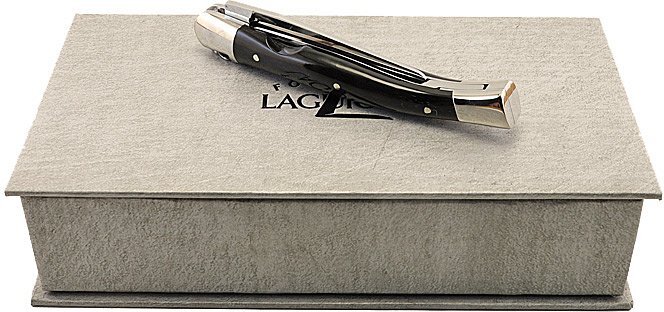Curapipe Forge De Laguiole in polished steel with black horn handles. The unmistakable design of the famous Laguiole knife transformed into a precious pipe cleaner, entirely handcrafted. On the back of the pipe cleaner, we find the hand-engraved steel spine and the characteristic bee on the spring mechanism. The pipe cleaner consists of a pestle, a tip and a practical small knife. The latter has a rounded tip so that it can scrape the crust from the stove without cutting into or damaging the bottom of the stove. The blade is not overly sharp so as not to damage the stove. It is considered the most prestigious pipe cleaner that any smoker could aspire to own. Its construction makes it almost indestructible. Unfortunately, it no longer comes with the elegant leather pouch.
It is 102 mm long and the pestle has a diameter of 11 mm. The blade is 61 mm long and the tip is 57 mm long. It weighs 64 g and comes with a suede leather case with the Forge De Laguiole logo, so that it can be stored in your pocket without getting dirty
For a product of this calibre, it seems only right to provide some historical background
The Forge de Laguiole factory was founded in 1987. This marked the rebirth of Laguiole knife production in the town where they originated. Honouring their venerable heritage, Forge de Laguiole crafts its creations using traditional techniques and materials in pursuit of the art of knife-making. The first folding knife produced in Laguiole in the 1820s was the Laguiole Droit, a straight knife without a decorated bee and with a forced notch. Between 1850 and 1860, the current shape of the Laguiole knife appeared and gradually became more refined. The blade curves slightly in the Yatagan style and the handle has an elegant shape
In 1909, the first bee appeared in place of the floral motif. Legend has it that Napoleon I allowed the inhabitants of Laguiole to have a bee on the town's coat of arms to reward them for their courage. However, there is no written evidence to confirm this legend. According to another legend, Napoleon III granted the use of the bee, although this can also be refuted. It has also been called a fly by some manufacturers. Whether it is a fly or a bee, its name is a mystery shrouded in legend. Since the 1960s, the production of handmade knives has been minimal, and in the early 1980s, knife manufacturing in Laguiole almost ceased to exist
In 1985, a group of enthusiasts created the conditions for the return of Laguiole knife manufacturing to its birthplace. The rebirth of the Forge de Laguiole became a reality in 1987. Every stage of knife production is now carried out in its place of origin. From the outset, they worked to develop their manufacturing skills while respecting traditional know-how. The Laguiole knife has become a cult object, a design reference synonymous with art de vivre





